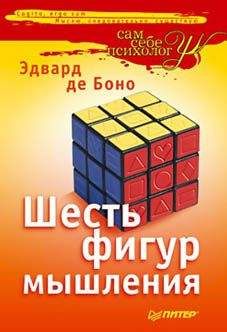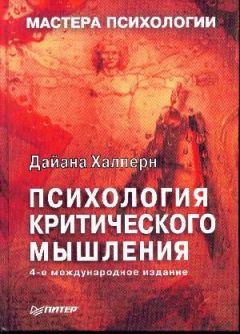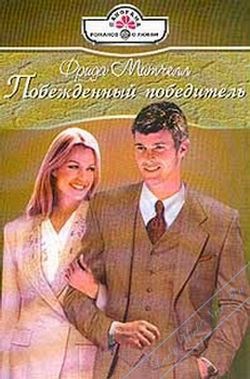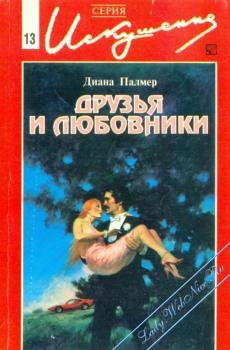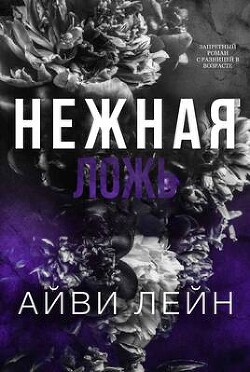Дайана Халперн - Психология критического мышления
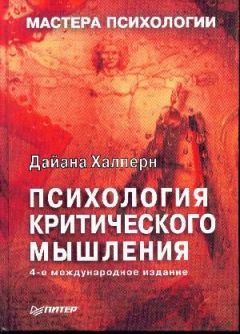
Помощь проекту
Психология критического мышления читать книгу онлайн
Hutchings P. (1986). Some late night thoughts on teaching creativity. American Association for Higher Educawn, 39, 9-14.
Izawa С(1993). Efficient learning: The total time, exposure duration, frequency, and programming of the study phase. In С Izawa (Ed.), Cognitive psychology applied (pp. 43-78). Hillsdale, NJ: Lawrence Erlbaum Associates.
Izawa C, Hayden R. G. (1993). Race against time: Toward the principle of optimization in learning and retention. In C. Izawa (Ed.), Cognitive psychology applied (pp. 15-42). Hillsdale, NJ: Lawrence Erlbaum Associates.
Jacoby L. L., Kelley С. М., Dywan, J. (1989). Memory attributions. In H. L. Roedinger amp; F. I M. Craik (Eds.), Varietes of memory and consciousness: Essays in honor of Endel Tulving (pp. 391 -422). Hillsdale, NJ: Lawrence Erlbaum Associates.
James W. (1890). The principles of psychology New York: Holt.
Janis I. L. (1989). Crucial decisions: Leadership in policy making and crisis management. New York: The Free Press.
Janis I. L., Mann L. (1977). Decision making: A psychological analysis of conflict, choice and commitment. New York: The Free Press.
Jason G. (1987). Are fallacies common? A look at two debates. Informal Logic, 8, 81-92.
Jensen A. R. (1980). Bias in mental testing. New York: The Free Press.
Jensen A. R. (1981). Straight talk about mental tests. New York: The Free Press.
Johnson M. K., Raye C. L. (1981). Reality monitoring. Psychological Review, 88,67-85.
Johnson-Laird P. N… Byrric R. M. J. (1991). Deduction. Hillsdale, NJ: Lawrence Erlbaum Associates.
Johnson-Laird P. N… Legrenzi P., Legrenzi M. (1972). Reasoning and a sense of reality. British Journal of Psychology. 63, 395-400.
Johnson-Laird P. N., Wason P. C. (1970). A theoretical analysis of insight into a reasoning task. Cognitive Psychology, 1, 134-148.
Johnson-Laird P. N., Wason P. С(Eds). (1977). Thinking Readings in cognitive science. Cambridge, England: Cambridge University Press.
Kahane H. (1980). Logic and contemporary rhetoric: The use of reason in everyday life (2nd ed.). Bel-mont, CA: Wadsworth.
Kahane H. (1992). Logic and contemporary rhetoric: The use of reason in everyday life (6th ed.). Bel-mont, CA: Wadsworth.
Kahneman D., Tver sky A. (1973). On the psychology of prediction. Psychological Review, 80, 237-251.
Kahneman D., Tversky A. (1979). Prospect theory: An analysis of decision under risk. Econometrica, 47, 263-291.
Kamin L. J. (1974). The science and politics of IQ. New York: Wiley.
Kavanaugh D. J., Bower G. H. (1985). Mood and self-efficacy: Impact of joy and sadness on perceived capabilities. Cognitive Therapy amp; Research, 9, 507-525.
Kelley D. (1988). The art of reasoning. New York: Norton.
Kellogg R. T. (1990, Fall). Effectiveness of prewriting strategies as a function of task demands. American Journal of Psychology, pp. 327-342.
Kidd V. (1991, Fall). An analysis of the California tobacco education campaign's visual anti-smoking messages. Feedback, 32,14-18.
Kimble G. A. (1978). How to use (and misuse) statistics. Englewood Cliffs, NJ: Prentice-Hall.
King A. (1989). Effects of self-questioning training on college students' comprehension of lectures. Contemporary Educational Psychology, 14, 1-16.
King A. (1992). Facilitating elaborative learning through guided student-generated questioning. Educational Psychologist, pp. 111-126.
King A. (1994). Inquiry as a tool in critical thinking. In D. F. Halpern (Ed.), Changing college classrooms: New teaching and learning strategies in an increasingly complex world (pp. 13-38). San Francisco: Jossey-Bass.
King A. (1995). Inquiring minds really do want to know: Using questioning to teach critical thinking. In D. F. Halpern amp; S. G. Nummedal (Eds.), Psychologists teach critical thinking [Special issue]. Teaching of Psychology, 22,13-17.
Klaczynski P. A. (1993). Reasoning schema effects on adolescent rule acquisition and transfer. Journal of Educational Psychology, 85, 679-692.
Klein G. A., WeizenfeldJ. (1978). Improvement of skills for solving ill-defined problems. Educational Psychologist, 13, 31-41.
Kneller G. F. (1965). The art and science of creativity. New York: Holt, Rinehart amp; Winston.
Knight K., Dansereau D. F. (1992). Tools for drug and alcohol education: Using decision worksheets in personal problem solving. Journal of Drug Education, 22(3), 261-271.
Koestler A. (1964). The act of creation. London: Hutch-inson.
Kohl H. (1981). A book of puzzlements: Play and invention with language. New York: Schocken Books.
Kohler W. (1925). The mentality of apes. New York: Harcourt, Brace.
Kohler W. (1969). The task of Gestalt psychology. Princeton, NJ: Princeton University Press.
Koriat A., Lihtenstein S., Fischhoff B. (1980). Reasons for confidence. Journal of Experimental Psychology. Human Learning and Memory, 6,107-118.
Kruglanski A. W. (1992). On methods of good judgment and good methods of judgment: Political decisions and the art of the possible. Political Psychology, 13,455-475.
Kuhn D. (1993, January). Connecting scientific and informal reasoning. Merrill-Palmer Quarterly, pp. 74-103.
Kuhn D., Weinstock M., Flaton R. (1994). How well do jurors reason? Competence dimensions of individual variation in a juror reasoning task. Psychological Science, 5, 289-296
Kunda Z., Nisbett R. E. (1986). The psychometrics of everyday life. Cognitive Psychology, 18,195-224.
LangerE. J. (1989). Mindfulness. Reading, MA: Addison-Wesley
Langer E. (1994, July). Improving the quality of thinking in a changing world. Paper presented at the Sixth International Conference on Thinking, Cambridge, MA.
LangerE. J., Blank A., Chanowitz B. (1978). The mind-lessness of ostensibly thoughtful action: The role of «placebic» information in interpersonal interaction. Journal of Personality and Social Psychology, 36, 635-642.
Langley P., Simon H. A., Bradshaw G. L., Zytkow J. M. (1987). Scientific discovery: Computational explorations of the creative process. Cambridge. MA: "MIT Press.
LangrehrS. (1990) Sharing thinking strategies. Bloom-ington, IN: National Educational Service.
Larrick R. P., Morgan J. N… Nisbett R. E. (1990). Teaching the use of cost-benefit reasoning in everyday life. Psychological Science, 1, 362-370.
Lee A.M. (1953). How to understand propaganda. New York: Holt, Rinehart amp; Company.
Leedy P. D. (1981). How to read research and understand it. New York: Macmillan.
Lehman D. R., Lempert R. 0., Nisbett R. E. (1988). The effects of graduate training on reasoning: Formal discipline and thinking about everyday-life events. American Psychologist, pp. 431-442.
Lehman D. R., Nisbett R. E. (1990). A longitudinal study of the effects of undergraduate training on reasoning. Developmental Psychology, 26,431-442.
Leive C. (1994, April). Miss America. Glamour, pp. 234-237,275-281.
Levi D. S. (1991). Critical thinking and logic. Salem, WI: Sheffield.
Levine M. (1994). Effective problem solving (2nd ed.) Englewood Cliffs, NJ: Prentice-Hall.
Lewis А. В., Mayer R. E. (1987). Students' miscomprehension of relational statements in arithmetic word problems. Journal of Educational Psychology, 79, 363-371.
Lichtenstein S., Slovic P., Fischoff В., Layman M., Combs B. (1978). Judged frequency of lethal events. Journal of Experimental Psychology. Human Learning and Memory, 4, 551-578.
Lister P. (1992, July). A skeptics guide to psychics. Redbook, pp. 103-105, 112-113.
Little L. W., Greenberg I. (1991) Problem solving, critical thinking, and communication skills New York: Longman.
Lochhead J. Clement J. (Eds.). (1979). Cognitive process instruction: Research on teaching thinking skills. Philadelphia: Franklin Institute Press.
Lockhart R. S., Lamon M., Gick M. L. (1988). Conceptual transfer in simple insight problems. Memory and Cognition, 16, 36-44.
Loftus E. F. (1979). Eyewitness testimony. Cambridge, MA; Harvard University Press.
Loftus E. F. (1980). Memory: Surprising new insights into how we remember and why we forget. Reading, MA: Addison-Wesley.
Loftus E. F. (1993). The reality of repressed memories. American Psychologist, 44,518-537.
Loftus E. R, Ketchum K. (1994). The myth of repressed memory: False memories and the accusations of sexual abuse. New York: St. Martin's Press.
Loftus G.R., Loftus E. F. (1982). Essence of statistics. Monterey, CA: Brooks/Cole.
The Long Term View. (1994. Summer). Has American education forsaken critical thinking? [Special issue]. (Vol. 2, No. 3). Andover: Massachusetts School of Law.
Lopes L. L. (1982). Doing the impossible: A note on induction and the experience of randomness. Journal of Experimental Psychology: Learning. Memory amp; Cognition, 8, 626-636.
Lorayne H. (1975). Remembering people. New York: Stein amp; Day.
Lorayne H., Lucas J. (1974). The memory book. New York: Stein amp; Day. (Also published in paperback by Ballantine Books, 1975)
Lord C, Ross L., Leppet M. (1979). Biased assimilation and attitude polarization: The effects of prior theories on subsequently considered evidence. Journal of Personality and Social Psychology, 37, 2098-2109.
Lowenfeld V. (1962). Creativity: Education's stepchild. In S., J. Parnes amp; H. F. Harding (Eds.), A source book for creative thinking. New York: Scribner's.
Luchins A. S. (1942). Mechanization in problem solving: The effect of Einstellung. Psychological Monographs, 54(6, Whole No. 248).
Macmillan Publishers (1989). Macmillan dictionary of quotations. New York: Author.
Maier N. R. F. (1931). Reasoning in humans II: The solution of a problem and its appearance in consciousness. Journal of Comparative Psychology, 12,181-194.
Mann L. (1972). Use of a «balance sheet» procedure to improve the quality of personal decision making: A field experiment with college applicants. Journal of Vocational Behavior, 2, 291-300.
Marsh J. G., Shapira Z. (1982). Behavioral decision theory and organizational decision theory. In G. R.Ungson, amp; D. N. Braunstein (Eds.), Decision making: An interdisciplinary inquiry. Boston, MA: Kent.
Matlin M. (1994). Cognition (3rd. ed.). Orlando, FL: Harcourt Brace.
Mayer R. E. (1987). Educational psychology A cognitive approach. Boston: Little, Brown.
Mayer R. E. (1992). Teaching of thinking skills in the sciences and mathematics. In D. F. Halpern (Ed.), Enhancing thinking skills in Ihe sciences and mathematics (pp. 95-116). Hillsdale, NJ: Lawrence Er-lbaum Associates.
McCormick С. В., Levin I. R. (1987). Mnemonic prose-learning strategics. In M. A. McDaniel amp; M. Press-ley (Eds.), Imagery and related mnemonic processes (pp. 392-406). New York: Springer-Verlag.
McGuire W. /. (1981). The probabilogical model of cognitive structure and attitude change. In R. E. Petty, Т. М. Ostrom, amp; Т. С Brock (Eds.), Cognitive responses in persuasion. Hillsdale, NJ: Lawrence Erlbaum Associates.
McKeachie W. J. (1992). Update: Teaching thinking. In D. J. Stroup and R. Allen (Eds.), Critical thinking: A collection of readings (p. 3). Dubuque, IA: Brown.
McKim R. H. (1980). Thinking visually: A strategy manual for problem solving. Belmont, CA: Wad-sworth.
McKinnon J. W., Renner J. W. (1971). Are colleges concerned with intellectual development? American Journal of Psychology. 39, 1047-1052
McTighe J. (1986). Thinking about adolescent thinking. The early adolescence magazine, 1,7-13.
Mednick S. A., Mednick M. T. (1967). Remote associates test: Examiners manual. Boston: Houghton Mifflin.
Meirovitz M. (1985). ThinkAbility. Hillsdale, NJ: Lawrence Erlbaum Associates.
Merron K., Fisher D., Torbert W. R. (1987). Meaning making and management action. Croup amp; Organization Studies, 12, 274-286.
Messer W. S., Griggs R. A. (1989). Student belief and involvement in the paranormal and performance in
introductory psychology. Teaching of Psychology, 16(4), 187-191.
Miller J. Ј., Jr. (1972). Words, self, reality: The rhetoric of imagination. New York: Dodd, Mead.
Milne A. A. (1926). Winnie the Pooh. New York: Dutton.
Moore B. N., Parker R. (1994). Critical thinking (4th ed.). Mountain View, CA: Mayfield.
Morgan J. J. В., Morton J. T. (1944). The distortion of syllogistic: reasoning produced by personal convictions. Journal of Social Psychology, 20, 39-59.

